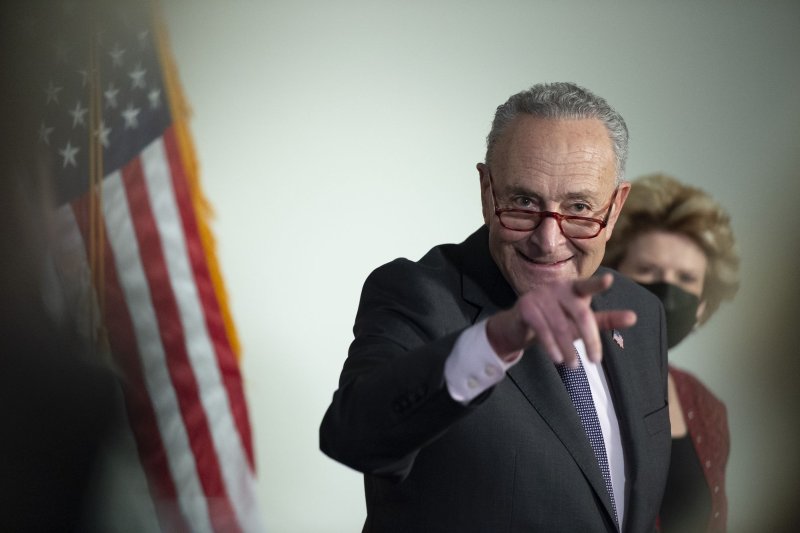
A group of bipartisan lawmakers announced an agreement on legislation to reauthorize the Violence Against Women Act on Wednesday, which does not include a provision to close the so-called "boyfriend loophole."
Photo by Jim Lo Scalzo/EPA-EFE
Feb. 9 (UPI) -- A bipartisan group of lawmakers on Wednesday announced an agreement on legislation to reauthorize the Violence Against Women Act that removes a key provision related to gun ownership.
Sens. Dianne Feinstein, D-Calif., Dick Durbin, D-Ill., Lisa Murkowski, R-Ala., and Joni Ernst, R-Iowa, announced the legislation that will "reauthorize and strengthen" the law for the first time in nearly a decade.
Feinstein said the bill "preserves the good work of the last reauthorization bill in 2013" and will strengthen "existing programs to support survivors and to prevent and to respond to domestic violence, and that's dating violence and sexual assault and stalking."
Further, she said the legislation will seek to expand services for domestic abuse survivors including "survivors in rural communities, LGBT survivors," as well as survivors with disabilities and strengthen the criminal justice response to domestic violence.
However, the bill does not include a provision that advocates say would close the so-called "boyfriend loophole" by extending restrictions barring individuals convicted of a misdemeanor crime of domestic violence that currently only includes spouses or formerly married partners to dating partners.
"Now, this isn't a perfect bill, I regret the boyfriend loophole is not addressed," Feinstein said. "Many of us have tried very hard to get there. But it's a good bill. And we need to finally get a Violence Against Women Act reauthorization to the president."
The provision, however, drew criticism from guns rights activists who panned it as an unnecessary restriction on gun ownership.
Feb. 9 (UPI) -- A bipartisan group of lawmakers on Wednesday announced an agreement on legislation to reauthorize the Violence Against Women Act that removes a key provision related to gun ownership.
Sens. Dianne Feinstein, D-Calif., Dick Durbin, D-Ill., Lisa Murkowski, R-Ala., and Joni Ernst, R-Iowa, announced the legislation that will "reauthorize and strengthen" the law for the first time in nearly a decade.
Feinstein said the bill "preserves the good work of the last reauthorization bill in 2013" and will strengthen "existing programs to support survivors and to prevent and to respond to domestic violence, and that's dating violence and sexual assault and stalking."
Further, she said the legislation will seek to expand services for domestic abuse survivors including "survivors in rural communities, LGBT survivors," as well as survivors with disabilities and strengthen the criminal justice response to domestic violence.
However, the bill does not include a provision that advocates say would close the so-called "boyfriend loophole" by extending restrictions barring individuals convicted of a misdemeanor crime of domestic violence that currently only includes spouses or formerly married partners to dating partners.
"Now, this isn't a perfect bill, I regret the boyfriend loophole is not addressed," Feinstein said. "Many of us have tried very hard to get there. But it's a good bill. And we need to finally get a Violence Against Women Act reauthorization to the president."
The provision, however, drew criticism from guns rights activists who panned it as an unnecessary restriction on gun ownership.
"The boyfriend loophole is a play straight from the Biden gun control agenda. It's just gun control," Aidan Johnson, director of federal affairs at Gun Owners of America said.
Actress Angelina Jolie, who has lobbied for the bill to be reauthorized, lamented that there are "many people for whom this legislation comes too late."
"The women who have suffered through this system with little or no support who still carry the pain and trauma of their abuse," said Jolie. "The young adults who have survived abuse and emerged stronger not because of the child protective system, but despise it. And the women and children who have died, who could have been saved."
President Joe Biden, who wrote the original bill, applauded the senators for reaching a compromise.
"In the nearly three decades since its passage, the law has been reauthorized three times with broad bipartisan support," Biden said. "Each time, I have helped work to strengthen its protections -- expanding access to safety and resources for all survivors, particularly those from marginalized communities."









